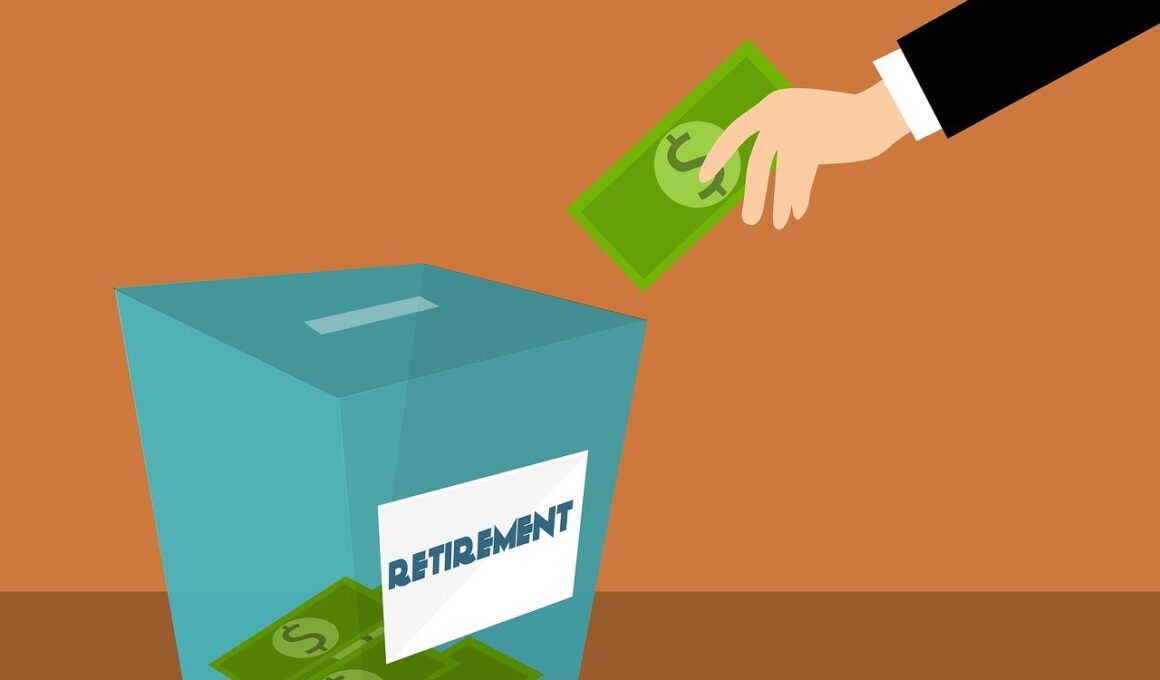Retirement Planning Tips for Self-Employed Individuals
Self-employed individuals face unique challenges when it comes to retirement planning. Unlike traditional employees, they do not have access to employer-sponsored retirement plans like 401(k)s. Therefore, creating a solid retirement strategy is essential for financial security in your later years. Begin by identifying your retirement goals, including when you plan to retire and the lifestyle you wish to maintain. Consider the amount of money you will need to sustain that lifestyle and calculate a realistic savings target. Employing tax-advantaged retirement accounts, such as a SEP IRA or a Solo 401(k), can significantly boost your savings. Each of these options has different contribution limits, so choose one that best fits your income level. It’s also wise to diversify your investments, exploring various options like stocks, bonds, and mutual funds. Regularly review your retirement savings and adjust your strategy as needed over time. Setting up an automatic contribution plan can help you save consistently and prevent the temptation to raid your savings for immediate expenses. Consulting with a financial advisor can also provide tailored guidance for your specific situation.
Establishing an emergency fund is another vital element in retirement planning for the self-employed. This fund should cover three to six months of living expenses, enabling you to absorb potential income fluctuations or unexpected costs while you save for retirement. Consider placing your emergency fund in a high-yield savings account to maximize interest earnings while retaining quick access to funds. Having an emergency fund allows you to focus on your retirement savings without the anxiety of unforeseen expenses. Furthermore, securing adequate health insurance coverage is crucial for self-employed individuals. This can shield you from high medical bills that could otherwise hinder your retirement savings. Investing in supplemental health insurance or Health Savings Accounts (HSAs) can provide additional financial support. Lastly, consider the potential for long-term care needs as you age. Including long-term care insurance in your retirement plan can mitigate risks associated with high care costs, preserving your hard-earned retirement savings. Prioritizing both your current and future financial health sets the stage for a satisfying and stress-free retirement.
Understanding Tax Implications
Understanding tax implications is essential for self-employed individuals, particularly when planning for retirement. Tax laws can significantly impact your retirement savings strategy. Self-employed individuals are responsible for paying both halves of Social Security taxes, which means you should account for this in your retirement budget. Furthermore, different retirement accounts offer varying tax advantages. For instance, contributions to traditional IRAs may be tax-deductible, lowering your taxable income in the current year but requiring you to pay taxes upon withdrawal in retirement. Conversely, Roth IRAs are funded with after-tax dollars, allowing qualified withdrawals to remain tax-free. This choice can have long-lasting effects on your financial planning. Consider your current tax bracket and project your retirement tax situation to decide which account type aligns better with your financial goals. Hiring a tax professional can help you navigate the complexities of tax deductions related to your self-employment income. They can also assist in optimizing your contributions to retirement accounts throughout the year, ensuring you maximize your potential savings. Evaluate your options thoroughly to tailigrate tax benefits to your retirement strategy effectively.
As the self-employed individual approaches retirement age, it’s crucial to shift your focus from accumulation to preservation. Many self-employed people tend to prioritize rapid asset growth in earlier years, but this strategy may need reevaluation as retirement nears. Begin by assessing your portfolio risk tolerance and consider transitioning to more conservative investments to protect your assets from market volatility. This ensures your retirement portfolio will remain intact when you start withdrawing funds. Set realistic withdrawal rates to maintain your savings over time; many experts suggest a 4% rule to balance your withdrawals with long-term sustainability. However, understanding your unique financial situation will personalize this strategy. Another consideration is Social Security benefits, which can play a vital role in your retirement income. Research your eligibility and projected benefits; you may have the option to withdraw benefits earlier at a reduced rate or wait to increase the monthly amount. Planning when to claim Social Security is critical to maximizing that income stream for retirement. Discussing these strategies with a retirement coach may provide valuable insights and further refine your approach as retirement approaches.
Creating Passive Income Streams
Creating passive income streams can significantly boost your financial security during retirement. For self-employed individuals, establishing various income sources can supplement your retirement savings while providing flexibility in your lifestyle. Consider investing in rental properties or real estate, which can generate recurring income while appreciation adds to your overall wealth. Additionally, explore options like dividend-paying stocks or mutual funds to secure a steady income flow from your investments. Another avenue could be launching an online business or producingdigital products, which can generate passive income without continual active involvement. Writing eBooks, creating online courses, or developing subscription services can put your expertise to work and create an ongoing income stream. However, assess the market demand and your capabilities before diving in. Furthermore, consider the potential of peer-to-peer lending platforms that allow your money to earn interest by lending to individuals or small businesses. While these opportunities may entail some risk, they can diversify your income portfolio and improve financial resilience during retirement. Assess your interests and skills to identify potential passive income opportunities aligned with your long-term plans.
Another essential consideration is setting aside funds specifically allocated for potential healthcare needs during retirement. The average retiree faces increasing healthcare costs, which can strain retirement savings if not planned appropriately. Research various long-term care insurance options to identify coverage that protects against substantial out-of-pocket expenses related to medical care. Understanding the different plans available can help you choose a policy that aligns with your retirement goals. Additionally, explore Medicare options available to self-employed individuals. Familiarize yourself with Medicare plans, eligibility, and coverage options to prevent unexpected expenses. Many retirees opt for Medicare Advantage plans to cover additional costs that traditional Medicare does not address, which is a strategic way to manage healthcare expenditures. Moreover, creating a holistic retirement budget that factors in potential healthcare costs will present a clearer picture of your savings needs. By planning for these necessary expenses, you can develop a more realistic retirement spending plan. Prioritizing healthcare in your retirement strategy alleviates potential financial burdens and ensures a more comfortable and secure lifestyle.
Conclusion
In conclusion, effective retirement planning is crucial for self-employed individuals to maintain financial stability and achieve their retirement goals. By establishing a comprehensive strategy that includes a retirement account, emergency fund, understanding tax implications, and creating passive income streams, self-employed individuals can enhance their financial prospects. Evaluating your unique financial situation, setting clear retirement goals, and consulting with finance professionals can greatly benefit your planning process. Additionally, maintaining awareness of healthcare costs, Social Security benefits, and potential investment opportunities will provide a well-rounded retirement strategy. Keep in mind that retirement planning is an ongoing process requiring flexibility and adjustments as life circumstances change. Regularly reviewing your progress and making necessary modifications ensures you remain on track. Emphasizing financial literacy and understanding your options empowers you to take charge of your retirement planning. Finally, remember that it’s never too early—or too late—to start planning for your retirement. The earlier you take proactive measures, the safer and more secure your financial future will be.
By implementing these retirement planning tips tailored to self-employed individuals, you can pave the way for a secure financial future. Whether you are just starting your journey as a self-employed individual or are nearing retirement, it’s essential to have a systematic approach to ensure that you are prepared for the days ahead. Begin with a clear vision for the future and actively review your financial situation to identify any adjustments needed along the way. Building a supportive network of financial advisors or peers who understand the unique nuances of self-employment can also prove invaluable in your retirement journey. Remember, retirement planning is a marathon, not a sprint. Consistency and diligence are crucial. The earlier you begin saving, investing, and making informed financial decisions, the greater the benefits you will enjoy later. Take charge of your retirement today, and work diligently towards financial independence. Empower yourself with knowledge, resources, and a strategic plan that puts you in control of your financial future. You will not only strengthen your retirement readiness but also cultivate confidence in your long-term financial outcomes. Start laying the groundwork for a fruitful and enjoyable retirement now to reap the rewards later on.


